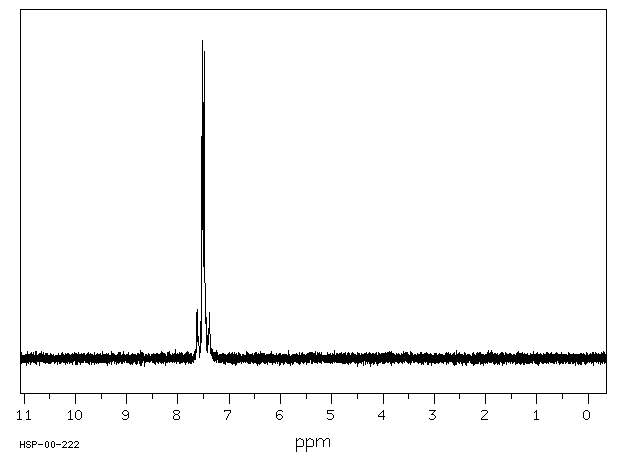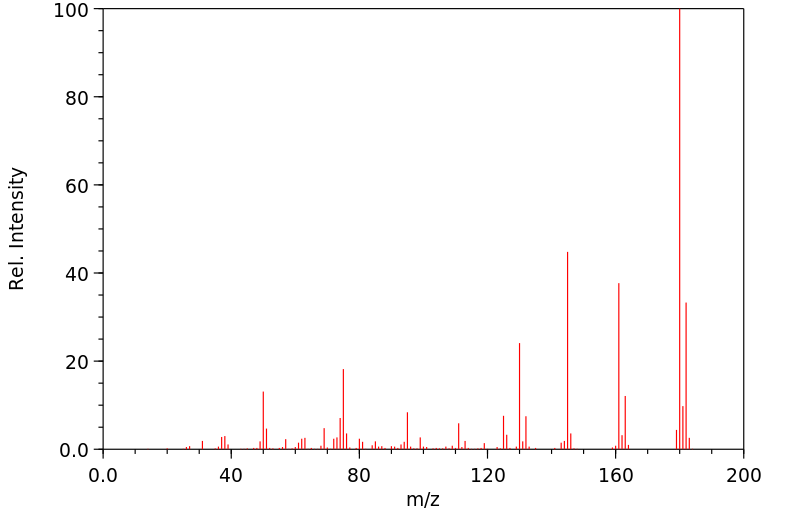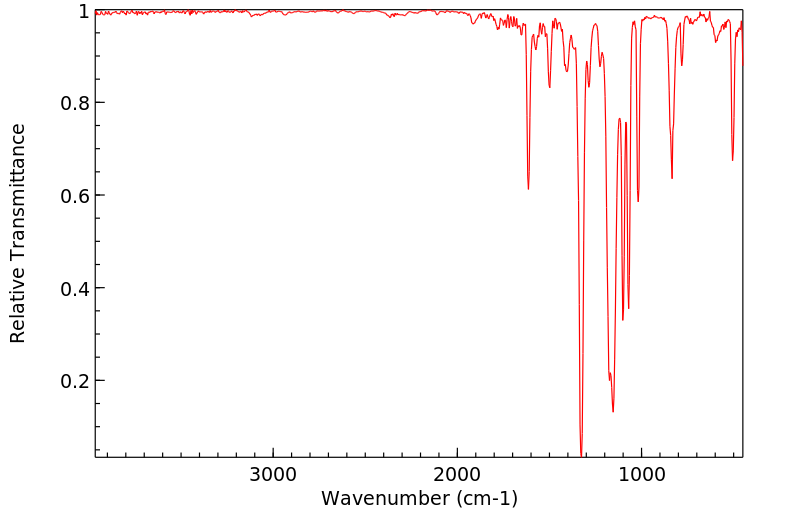对氯三氟甲苯 | 98-56-6
中文名称
对氯三氟甲苯
中文别名
4-氯-α,α,α-三氟甲苯;4-氯三氟甲苯;1-氯-4-(三氟甲基)苯;对氯苄川三氟;对氯三氟苄;对氯三氟甲基苯;三氟甲基氯苯;三氟-3-氯甲苯
英文名称
4-chlorobenzotrifluoride
英文别名
1-chloro-4-(trifluoromethyl)benzene;p-chlorotrifluorotoluene;p-chlorobenzotrifluoride;4-(trifluoromethyl)chlorobenzene
CAS
98-56-6
化学式
C7H4ClF3
mdl
MFCD00000627
分子量
180.557
InChiKey
QULYNCCPRWKEMF-UHFFFAOYSA-N
BEILSTEIN
——
EINECS
——
-
物化性质
-
计算性质
-
ADMET
-
安全信息
-
SDS
-
制备方法与用途
-
上下游信息
-
文献信息
-
表征谱图
-
同类化合物
-
相关功能分类
-
相关结构分类
物化性质
-
熔点:-36 °C (lit.)
-
沸点:136-138 °C (lit.)
-
密度:1.353 g/mL at 25 °C (lit.)
-
闪点:117 °F
-
溶解度:56mg/l
-
暴露限值:ACGIH: TWA 2.5 mg/m3NIOSH: IDLH 250 mg/m3
-
LogP:3.7 at 25℃
-
物理描述:P-chlorobenzotrifluoride is a clear colorless liquid with an aromatic odor. (NTP, 1992)
-
颜色/状态:Water-white liquid
-
气味:Strong though not unpleasant aromatic odor
-
蒸汽密度:6.24 (NTP, 1992) (Relative to Air)
-
蒸汽压力:7.63 mm Hg at 25 °C
-
大气OH速率常数:2.40e-13 cm3/molecule*sec
-
分解:When heated to decomposition it emits toxic fumes of /hydrogen chloride/ and /fluorine/.
-
折光率:Index of refraction = 1.4431 at 30 °C/D
-
保留指数:836.3;836.3
-
稳定性/保质期:
- 避免与强氧化剂和强碱接触,易燃。
- 有毒。吸入会导致中毒,并有刺激性。遇高温、明火或氧化剂时存在燃烧危险。
计算性质
-
辛醇/水分配系数(LogP):3.8
-
重原子数:11
-
可旋转键数:0
-
环数:1.0
-
sp3杂化的碳原子比例:0.142
-
拓扑面积:0
-
氢给体数:0
-
氢受体数:3
ADMET
代谢
当给予大鼠一次口服剂量为1 mg/kg对氯(三氟甲基-(14)C)苯三氟甲醚时,3-4%和14-15%的施用(14)C分别通过粪便和尿液排出。主要的尿代谢物是对二羟基苯三氟甲醚和4-氯-3-羟基苯三氟甲醚的葡萄糖苷酸(每种都代表施用(14)C的3-4%),以及少量的对氯苯三氟甲醚的巯基尿酸结合物。对氯苯三氟甲醚本身被大鼠迅速呼出(占施用剂量的62-82%)并且在粪便中是主要的(14)C标记残留物。组织中(14)C标记残留物的水平较低,但大鼠体内剂量后4天的小量放射性标记物(施用剂量的1%)也被鉴定为对氯苯三氟甲醚,并且主要发现于脂肪中。
When rats were given a single oral dose of 1 mg/kg p-chloro(trifluoromethyl-(14)C) benzotrifluoride 3-4%, and 14-15% of the applied (14)C were excreted in feces and urine, respectively. The major urinary metabolites were glucuronides of dihydroxybenzotrifluoride and 4-chloro-3-hydroxybenzotrifluoride (each representing 3-4% of the applied (14)C), and minor amounts of a mercapturic acid conjugate of p-chlorobenzotrifluoride. p-Chlorobenzotrifluoride itself was rapidly expired by rats (62-82% of the applied dose) and was the major (14)C- labeled residue in feces. Levels of (14)C-labeled residues in tissues were low, but the small amount of radiolabel in the rat carcass 4 days after dosage (1% applied dose) was also identified as p-chlorobenzotrifluoride and was found predominantly in fat.
来源:Hazardous Substances Data Bank (HSDB)
毒理性
IARC Carcinogenic Agent:4-Chlorobenzotrifluoride
来源:International Agency for Research on Cancer (IARC)
毒理性
国际癌症研究机构(IARC)致癌物分类:2B组:可能对人类致癌
IARC Carcinogenic Classes:Group 2B: Possibly carcinogenic to humans
来源:International Agency for Research on Cancer (IARC)
毒理性
国际癌症研究机构专著:第125卷:(2020年)一些工业化学中间体和溶剂
IARC Monographs:Volume 125: (2020) Some Industrial Chemical Intermediates and Solvents
来源:International Agency for Research on Cancer (IARC)
毒理性
神经毒素 - 急性溶剂综合症
职业性肝毒素 - 次级肝毒素:在职业环境中的毒性效应潜力是基于人类摄入或动物实验的中毒案例。
国际癌症研究机构致癌物 - 3类:化学品无法被国际癌症研究机构分类。
Neurotoxin - Acute solvent syndrome
Occupational hepatotoxin - Secondary hepatotoxins: the potential for toxic effect in the occupational setting is based on cases of poisoning by human ingestion or animal experimentation.
IARC Carcinogen - Class 3: Chemicals are not classifiable by the International Agency for Research on Cancer.
来源:Haz-Map, Information on Hazardous Chemicals and Occupational Diseases
毒理性
大鼠LC50 = 22,000毫克/立方米
LC50 (rat) = 22,000 mg/m3
来源:Haz-Map, Information on Hazardous Chemicals and Occupational Diseases
吸收、分配和排泄
对氯代α,α,α-三氟甲苯(CTFT)在作为水溶性α-环糊精(α-CD)分子包封悬浮液(α-CD载体)或玉米油溶液(玉米油载体)给药后的毒物动力学进行了比较。将雄性F344大鼠通过胃管给予CTFT,分别使用α-CD载体或玉米油载体,剂量水平为10、50或400 mg/kg。其他雄性F344大鼠通过静脉注射给予含有10% Tween 80的水溶液中的CTFT。从颈静脉插管中在给药后长达52小时内采集系列血液样本,并通过气相色谱测定全血中的CTFT浓度。CTFT从中心室的生物消除半衰期不受所用载体的影响;然而,从α-CD载体中吸收CTFT的速度比从玉米油载体中快得多。从α-CD载体和玉米油载体平均吸收半衰期分别为17分钟和98分钟。尽管吸收存在差异,但用两种载体给药的大鼠计算出的血药浓度-时间曲线下面积(AUC)没有观察到统计学差异。CTFT的剂量比例性在400 mg/kg范围内得到确立,并且两种载体的生物利用度均显示为完全。
Toxicokinetics of p-chloro-alpha,alpha,alpha-trifluorotoluene (CTFT) after administration as an aqueous alpha-cyclodextrin (alpha-CD) molecular encapsulation suspension (alpha-CD vehicle) or as a corn oil solution (corn oil vehicle) were compared. Male F344 rats were administered intragastrically CTFT in alpha-CD vehicle or corn oil vehicle at dose levels of 10, 50, or 400 mg/kg. Other male F344 rats were administered CTFT intravenously in a 10% Tween 80 aqueous solution. Serial blood samples were taken from a cannulated jugular vein for up to 52 hr after dosing and the CTFT concentrations in whole blood were determined by gas chromatography. The biological elimination half-life of CTFT from the center compartment was not affected by the vehicle used; however, absorption of CTFT from the alpha-CD vehicle was much faster than from the corn oil vehicle. The average absorption half-lives from the alpha-CD vehicle and corn oil vehicle were 17 and 98 min, respectively. Despite the differences in absorption, no statistical difference was observed in the calculated areas under the blood concentration versus time curves (AUC) obtained from rats dosed with either vehicle. Dose proportionality for CTFT was established up to 400 mg/kg and bioavailability was shown to be complete for both vehicles.
来源:Hazardous Substances Data Bank (HSDB)
安全信息
-
TSCA:Yes
-
危险等级:3
-
危险品标志:Xi
-
安全说明:S16,S24/25,S26,S36
-
危险类别码:R10,R36/37/38
-
WGK Germany:2
-
海关编码:29036990
-
危险品运输编号:UN 2234 3/PG 3
-
危险类别:3
-
RTECS号:XS9145000
-
包装等级:III
-
储存条件:1. 储存于阴凉、通风的库房。远离火种和热源,避免阳光直射。库温不宜超过30℃。保持容器密封,并与氧化剂、碱类及食用化学品分开存放,切忌混储。采用防爆型照明和通风设施,禁止使用易产生火花的机械设备和工具。储区应配备泄漏应急处理设备和合适的收容材料。 2. 本产品具有刺激性,建议使用镀锌铁桶包装,每桶净重200kg。储存于通风、防晒且防潮湿的地方。
SDS
| 第一部分:化学品名称 |
| 化学品中文名称: | 三氟-4-氯甲苯;三氟甲基氯苯 |
| 化学品英文名称: | 4-Chlorobenzotrifluoride;4-Chlorotrifluoromethylbenzene |
| 中文俗名或商品名: | |
| Synonyms: | |
| CAS No.: | 98-56-6 |
| 分子式: | C 7 H 4 ClF 3 |
| 分子量: | 180.56 |
| 第二部分:成分/组成信息 |
| 纯化学品 混合物 | |||
| 化学品名称:三氟-4-氯甲苯;三氟甲基氯苯 | |||
|
| 第三部分:危险性概述 |
| 危险性类别: | 第3.3类高闪点易燃液体 |
| 侵入途径: | 吸入 食入 经皮吸收 |
| 健康危害: | 吸入、摄入或经皮肤吸收后对身体有害。对眼睛、皮肤、粘膜和上呼吸道有刺激作用。 |
| 环境危害: | |
| 燃爆危险: |
| 第四部分:急救措施 |
| 皮肤接触: | 用肥皂水及清水彻底冲洗。就医。 |
| 眼睛接触: | 拉开眼睑,用流动清水冲洗15分钟。就医。 |
| 吸入: | 脱离现场至空气新鲜处。就医。 |
| 食入: | 误服者,饮适量温水,催吐。就医。 |
| 第五部分:消防措施 |
| 危险特性: | 遇高热、明火或氧化剂,有引起燃烧的危险。其蒸气比空气重,能在较低处扩散到相当远的地方,遇明火会引着回燃。遇水或高热能放出大量有毒的气体。 |
| 有害燃烧产物: | |
| 灭火方法及灭火剂: | 泡沫、二氧化碳、干粉。 |
| 消防员的个体防护: | |
| 禁止使用的灭火剂: | |
| 闪点(℃): | 46.7 |
| 自燃温度(℃): | |
| 爆炸下限[%(V/V)]: | |
| 爆炸上限[%(V/V)]: | |
| 最小点火能(mJ): | |
| 爆燃点: | |
| 爆速: | |
| 最大燃爆压力(MPa): | |
| 建规火险分级: |
| 第六部分:泄漏应急处理 |
| 应急处理: | 疏散泄漏污染区人员至安全区,禁止无关人员进入污染区,切断火源。建议应急处理人员戴好口罩、护目镜,穿工作服。禁止泄漏物进入受限制的空间(如下水道等),以避免发生爆炸。用砂土、蛭石或其它惰性材料吸收,收集于密闭容器中作好标记,等待处理。用水刷洗泄漏污染区,经稀释的污水放入废水系统。如大量泄漏,利用围堤收容,然后收集、转移、回收或无害处理后废弃。 |
| 第七部分:操作处置与储存 |
| 操作注意事项: | |
| 储存注意事项: |
| 第八部分:接触控制/个体防护 |
| 最高容许浓度: | 中 国 MAC:未制订标准前苏联 MAC:未制订标准美国TLV—TWA:未制订标准 |
| 监测方法: | |
| 工程控制: | 生产过程密闭,全面通风。 |
| 呼吸系统防护: | 作业工人应戴口罩。 |
| 眼睛防护: | 必要时戴化学安全防护眼镜。 |
| 身体防护: | 穿防静电工作服。 |
| 手防护: | 必要时戴防化学品手套。 |
| 其他防护: | 工作现场严禁吸烟。工作后,淋浴更衣。保持良好的卫生习惯。 |
| 第九部分:理化特性 |
| 外观与性状: | 无色透明液体。 |
| pH: | |
| 熔点(℃): | -33.4 |
| 沸点(℃): | 139.2 |
| 相对密度(水=1): | 1.342 |
| 相对蒸气密度(空气=1): | 6.24 |
| 饱和蒸气压(kPa): | |
| 燃烧热(kJ/mol): | |
| 临界温度(℃): | |
| 临界压力(MPa): | |
| 辛醇/水分配系数的对数值: | |
| 闪点(℃): | 46.7 |
| 引燃温度(℃): | |
| 爆炸上限%(V/V): | |
| 爆炸下限%(V/V): | |
| 分子式: | C 7 H 4 ClF 3 |
| 分子量: | 180.56 |
| 蒸发速率: | |
| 粘性: | |
| 溶解性: | 溶于部分有机溶剂。 |
| 主要用途: | 用于制造染料、颜料、药物、农药等。 |
| 第十部分:稳定性和反应活性 |
| 稳定性: | 在常温常压下 稳定 |
| 禁配物: | 强氧化剂、强碱。 |
| 避免接触的条件: | |
| 聚合危害: | 不能出现 |
| 分解产物: | 一氧化碳、二氧化碳、氯化氢、氟化氢。 |
| 第十一部分:毒理学资料 |
| 急性毒性: | |
| 急性中毒: | |
| 慢性中毒: | |
| 亚急性和慢性毒性: | |
| 刺激性: | |
| 致敏性: | |
| 致突变性: | |
| 致畸性: | |
| 致癌性: |
| 第十二部分:生态学资料 |
| 生态毒理毒性: | |
| 生物降解性: | |
| 非生物降解性: | |
| 生物富集或生物积累性: |
| 第十三部分:废弃处置 |
| 废弃物性质: | |
| 废弃处置方法: | |
| 废弃注意事项: |
| 第十四部分:运输信息 |
| |
| 危险货物编号: | 33649 |
| UN编号: | 2234 |
| 包装标志: | |
| 包装类别: | Ⅲ |
| 包装方法: | |
| 运输注意事项: | 储存于阴凉、干燥、通风良好的库房。远离火种、热源。仓温不宜超过30℃。保持容器密封。防止阳光直射。应与碱类、氧化剂、潮湿物品,等分开存放。禁止使用易产生火花的机械设备和工具。配备相应品种和数量的消防器 |
| RETCS号: | |
| IMDG规则页码: |
| 第十五部分:法规信息 |
| 国内化学品安全管理法规: | |
| 国际化学品安全管理法规: |
| 第十六部分:其他信息 |
| 参考文献: | 1.周国泰,化学危险品安全技术全书,化学工业出版社,1997 2.国家环保局有毒化学品管理办公室、北京化工研究院合编,化学品毒性法规环境数据手册,中国环境科学出版社.1992 3.Canadian Centre for Occupational Health and Safety,CHEMINFO Database.1998 4.Canadian Centre for Occupational Health and Safety, RTECS Database, 1989 |
| 填表时间: | 年月日 |
| 填表部门: | |
| 数据审核单位: | |
| 修改说明: | |
| 其他信息: | 6 |
| MSDS修改日期: | 年月日 |
制备方法与用途
对氯三氟甲苯简介
对氯三氟甲苯(4-chlorobenzotrifluoride)是一种无色透明的液体,带有卤代苯的独特气味。它不溶于水,但能与苯、甲苯、乙醇、乙醚及卤代烃等有机溶剂混溶。
应用对氯三氟甲苯是重要的有机合成中间体,在医药、农药和染料等领域有广泛应用。作为农药的合成原料之一,它用于制备多种含氟杀虫剂和除草剂,包括氟乐灵、乙丁氟乐灵、氟酯肟草醚、氟碘胺草醚及羧氟醚除草剂等。
化学性质常温下对氯三氟甲苯为液体,熔点 -36℃,沸点 139.2℃。密度 1.353,冰点 47℃。它能够溶于多种有机溶剂如苯、甲苯等。
用途主要作为除草剂如氟乐灵、乙氧氟草醚、三氟羧草醚、氟磺胺草醚、乙羧氟草醚及乳氟禾草灵的中间体,也可用于合成医药和染料。
生产方法制备过程包括氯化与氟化两个步骤。首先,将对氯甲苯投入光氯化反应器中,在120-150℃条件下通入氯气进行侧链光氯化反应,并通过气相色谱分析控制反应进程。接着,将产物减压蒸馏得对氯三氯甲苯,收率为90-95%。
随后,在氟化反应釜内加入4-5倍摩尔比的无水氟化氢并升温至1.9-2.4MPa下进行反应,直至压力稳定。反应生成的气体用碱液吸收后,通过中和、水蒸气蒸馏等方式提纯对氯三氟甲苯粗品,经精馏得到沸程为138-140℃的产品,收率为80-90%。
安全与储存对氯三氟甲苯属易燃液体,具有低毒性。急性口服毒性测试中,大鼠和小鼠的半致死量分别为13000毫克/公斤和11500毫克/公斤。它与二甲基亚磺酸钠反应可释放大量热量并可能引发爆炸;遇明火或受热分解会产生有毒卤化物气体。
储存时应保持低温干燥且通风良好,并需将氧化剂及食品原料分开存放运输,使用二氧化碳、砂土或泡沫灭火剂进行火灾扑救。
上下游信息
-
上游原料
中文名称 英文名称 CAS号 化学式 分子量 三氟甲苯 α,α,α-trifluorotoluene 98-08-8 C7H5F3 146.112 2,4-二氯三氟甲苯 2,4-dichloro-benzotrifluoride 320-60-5 C7H3Cl2F3 215.002 3,4,5-三氯三氟甲苯 1-trifluoromethyl-3,4,5-trichlorobenzene 50594-82-6 C7H2Cl3F3 249.447 对三氟甲基苯胺 4-Trifluoromethylaniline 455-14-1 C7H6F3N 161.127 4-碘三氟甲苯 4-Iodobenzotrifluoride 455-13-0 C7H4F3I 272.008 对溴三氟甲苯 p-trifluoromethylphenyl bromide 402-43-7 C7H4BrF3 225.008 对氯甲苯 4-chlorotoluene 106-43-4 C7H7Cl 126.586 -
下游产品
中文名称 英文名称 CAS号 化学式 分子量 三氟甲苯 α,α,α-trifluorotoluene 98-08-8 C7H5F3 146.112 3,4-二氯三氟甲苯 1,2-dichloro-4-(trifluoromethyl)benzene 328-84-7 C7H3Cl2F3 215.002 4-甲基三氟甲苯 4-methylbenzotrifluoride 6140-17-6 C8H7F3 160.139 对二三氟甲苯 1,4-bis(trifluoromethyl)benzene 433-19-2 C8H4F6 214.11 —— 1-(difluoromethyl)-4-(trifluoromethyl)benzene 2251-82-3 C8H5F5 196.12 3,4,5-三氯三氟甲苯 1-trifluoromethyl-3,4,5-trichlorobenzene 50594-82-6 C7H2Cl3F3 249.447 —— 1-(bromodifluoromethyl)-4-chlorobenzene 114467-75-3 C7H4BrClF2 241.463 3-氨基-4-氯三氟甲苯 3-Amino-4-chlorobenzotrifluoride 121-50-6 C7H5ClF3N 195.572 4-氯-3-氟三氟甲苯 4-chloro-3-fluorobenzotrifluoride 32137-20-5 C7H3ClF4 198.547 3-溴-4-氯三氟甲苯 3-bromo-4-chlorobenzotrifluoride 454-78-4 C7H3BrClF3 259.453 对三氟甲基苯胺 4-Trifluoromethylaniline 455-14-1 C7H6F3N 161.127 对三氟甲基苯酚 4-Trifluoromethylphenol 402-45-9 C7H5F3O 162.111 4-碘三氟甲苯 4-Iodobenzotrifluoride 455-13-0 C7H4F3I 272.008 4-(三氟甲基)苯硫酚 4-trifluoromethylbenzenethiol 825-83-2 C7H5F3S 178.178 4-氟三氟甲苯 4-Fluorobenzotrifluoride 402-44-8 C7H4F4 164.102 4-(三氟甲基)苄醇 4-(trifluoromethyl)benzylic alcohol 349-95-1 C8H7F3O 176.138 对氯甲苯 4-chlorotoluene 106-43-4 C7H7Cl 126.586 对三氟甲基苯腈 4-CF3C6H4CN 455-18-5 C8H4F3N 171.122 对三氟甲基苯乙烯 1-trifluoromethyl-4-vinyl-benzene 402-50-6 C9H7F3 172.15 对三氟甲基苯甲醛 4-Trifluoromethylbenzaldehyde 455-19-6 C8H5F3O 174.122 2-氯-5-三氟甲基苄醇 (2-chloro-5-(trifluoromethyl)phenyl)methanol 64372-62-9 C8H6ClF3O 210.583 1-氯-2-(氯甲基)-4-(三氟甲基)苯 1-chloro-2-(chloromethyl)-4-(trifluoromethyl)benzene 22902-87-0 C8H5Cl2F3 229.029 —— 2-(trifluoromethyl)naphthalene 581-90-8 C11H7F3 196.172 1-氯-4-[4-(三氟甲基)苯基]苯 4-chloro-4'-(trifluoromethyl)-1,1'-biphenyl 146741-82-4 C13H8ClF3 256.655 - 1
- 2
- 3
反应信息
-
作为反应物:描述:对氯三氟甲苯 在 盐酸 、 bis(acetylacetonate)nickel(II) 、 正丁基锂 、 二异丁基氢化铝 、 三苯基膦 、 zinc(II) chloride 作用下, 反应 3.0h, 生成 4-三氟甲基-联苯-2-甲酸参考文献:名称:Eaddy, John F., Organic Preparations and Procedures International, 1995, vol. 27, # 3, p. 367 - 372摘要:DOI:
-
作为产物:参考文献:名称:一种芳香族含氟化合物的连续合成方法及其合成设备摘要:本发明公开了一种芳香族含氟化合物的连续合成方法及其合成设备,包括以下步骤:芳香族氯化物自氟化反应塔的顶部进入,无水氟化氢液体自底部进入,在氟化反应塔内进行逆向氟化反应;尾气依次经过冷凝器和酸雾捕集器后,与无水氟化氢液体混合后共同自顶部进入;氟化反应塔的底部得到芳香族含氟化合物。连续合成设备包括氟化反应塔,氟化反应塔的氯化物进口连通有氯化物储罐;氟化反应塔的下部和中部分别设有氟化氢进口;氟化反应塔尾气出口依次连通有冷凝器、酸雾捕集器和混合器;混合器的出口连通所述氯化物进口;氟化反应塔的底部设有芳香族含氟化合物出口。本发明不仅实现了连续反应,而且工艺流程短,生产安全性高,产品质量稳定。公开号:CN107151200B
-
作为试剂:参考文献:名称:[EN] PROCESS FOR THE PREPARATION OF 4-SUBSTITUTED-1-(TRIFLUOROMETHOXY)BENZENE COMPOUNDS
[FR] PROCÉDÉ POUR LA PRÉPARATION DE COMPOSÉS DE 1-(TRIFLUOROMÉTHOXY)BENZÈNE 4-SUBSTITUÉ摘要:公开号:WO2016125185A3
文献信息
-
Efficient copper(I)-catalyzed C–S cross-coupling of thiols with aryl halides in an aqueous two-phase system作者:Xin-Yan Zhang、Xiao-Yan Zhang、Sheng-Rong GuoDOI:10.1080/17415993.2010.547197日期:2011.2.1A mild and convenient C–S bond formation reaction catalyzed by CuI/L-proline in an aqueous two-phase system was achieved, providing a simple method for the synthesis of aryl sulfides in good yields.
-
The first use of [PdBr2(imidazolidin-2-ylidene)(pyridine)] catalysts in the direct C-H bond arylation of C2-substituted furan and thiophene作者:Murat Kaloğlu、Nazan Kaloğlu、Namık Özdemir、İsmail ÖzdemirDOI:10.1007/s11164-021-04444-4日期:2021.7was determined by single-crystal X-ray diffraction study. The catalytic activities of all palladium complexes were evaluated in the direct C-H bond arylation of the 2-acetylfuran and 2-acetylthiophene with (hetero) aryl bromides and readily available and inexpensive aryl chlorides in presence of 1 mol% catalyst loading at 120 °C. Under the given conditions, (hetero)aryl halides were successfully applied摘要 ñ-杂环卡宾(NHC)连接的PEPPSI型钯络合物最近已用于杂芳烃的直接CH键芳基化。然而,在大多数已发表的著作中,已经使用了含有苯并咪唑和咪唑环的NHC配体,但是很少使用含有饱和咪唑啉环的NHC配体。因此,在这项研究中,合成了四种新的1,3-二取代的咪唑啉盐作为NHC配体前体,以及它们的四种新的PEPPSI型钯配合物。所有新化合物的结构均通过不同的光谱和分析技术进行了全面表征。钯配合物之一的更详细的结构表征是通过单晶X射线衍射研究确定的。在120℃下,负载1 mol%催化剂的条件下,在2-乙酰基呋喃和2-乙酰基噻吩与(杂)芳基溴化物和易得且廉价的芳基氯化物的直接CH键芳基化反应中,评估了所有钯配合物的催化活性。在给定的条件下,成功地使用了(杂)芳基卤化物作为芳基化试剂,以可接受的高收率获得了C5芳基化的呋喃和噻吩。 图形摘要
-
Development of a Unique Heterogeneous Palladium Catalyst for the Suzuki-Miyaura Reaction using (Hetero)aryl Chlorides and Chemoselective Hydrogenation作者:Tomohiro Ichikawa、Moeko Netsu、Masahiro Mizuno、Tomoteru Mizusaki、Yukio Takagi、Yoshinari Sawama、Yasunari Monguchi、Hironao SajikiDOI:10.1002/adsc.201700156日期:2017.7.3species. It was also applicable as a chemoselective hydrogenation catalyst, showing inactivity for the hydrogenolysis of tert‐butyldimethylsilyl (TBS) ethers, alkyl benzyl ethers, and benzyl alcohols. The tert‐amines on WA30 acted as moderate catalyst poisons for Pd, resulting in chemoselective hydrogenation. 7% Pd/WA30 was reused for at least five times without any loss of the hydrogenation catalytic
-
Zinc Trimethylsilylamide as a Mild Ammonia Equivalent and Base for the Amination of Aryl Halides and Triflates作者:Dae-Yon Lee、John F. HartwigDOI:10.1021/ol050141b日期:2005.3.1report that Zn[N(SiMe(3))(2)](2) is a mild ammonia equivalent and base for the palladium-catalyzed amination of aryl halides and triflates. In contrast to LiN(SiMe(3))(2), the combination of Zn[N(SiMe(3))(2)](2) and LiCl coupled with aryl halides and triflates containing base-sensitive functionality in high yields. In addition, aryl bromides coupled with aryl and alkylamines with the combination of
-
A general electrochemical strategy for the Sandmeyer reaction作者:Qianyi Liu、Beiqi Sun、Zheng Liu、Yi Kao、Bo-Wei Dong、Shang-Da Jiang、Feng Li、Guoquan Liu、Yang Yang、Fanyang MoDOI:10.1039/c8sc03346c日期:——Herein we report a general electrochemical strategy for the Sandmeyer reaction. Using electricity as the driving force, this protocol employs a simple and inexpensive halogen source, such as NBS, CBrCl3, CH2I2, CCl4, LiCl and NaBr for the halogenation of aryl diazonium salts. In addition, we found that these electrochemical reactions could be performed using anilines as the starting material in a one-pot
表征谱图
-
氢谱1HNMR
-
质谱MS
-
碳谱13CNMR
-
红外IR
-
拉曼Raman
-
峰位数据
-
峰位匹配
-
表征信息
同类化合物
(βS)-β-氨基-4-(4-羟基苯氧基)-3,5-二碘苯甲丙醇
(S,S)-邻甲苯基-DIPAMP
(S)-(-)-7'-〔4(S)-(苄基)恶唑-2-基]-7-二(3,5-二-叔丁基苯基)膦基-2,2',3,3'-四氢-1,1-螺二氢茚
(S)-盐酸沙丁胺醇
(S)-3-(叔丁基)-4-(2,6-二甲氧基苯基)-2,3-二氢苯并[d][1,3]氧磷杂环戊二烯
(S)-2,2'-双[双(3,5-三氟甲基苯基)膦基]-4,4',6,6'-四甲氧基联苯
(S)-1-[3,5-双(三氟甲基)苯基]-3-[1-(二甲基氨基)-3-甲基丁烷-2-基]硫脲
(R)富马酸托特罗定
(R)-(-)-盐酸尼古地平
(R)-(-)-4,12-双(二苯基膦基)[2.2]对环芳烷(1,5环辛二烯)铑(I)四氟硼酸盐
(R)-(+)-7-双(3,5-二叔丁基苯基)膦基7''-[((6-甲基吡啶-2-基甲基)氨基]-2,2'',3,3''-四氢-1,1''-螺双茚满
(R)-(+)-7-双(3,5-二叔丁基苯基)膦基7''-[(4-叔丁基吡啶-2-基甲基)氨基]-2,2'',3,3''-四氢-1,1''-螺双茚满
(R)-(+)-7-双(3,5-二叔丁基苯基)膦基7''-[(3-甲基吡啶-2-基甲基)氨基]-2,2'',3,3''-四氢-1,1''-螺双茚满
(R)-(+)-4,7-双(3,5-二-叔丁基苯基)膦基-7“-[(吡啶-2-基甲基)氨基]-2,2”,3,3'-四氢1,1'-螺二茚满
(R)-3-(叔丁基)-4-(2,6-二苯氧基苯基)-2,3-二氢苯并[d][1,3]氧杂磷杂环戊烯
(R)-2-[((二苯基膦基)甲基]吡咯烷
(R)-1-[3,5-双(三氟甲基)苯基]-3-[1-(二甲基氨基)-3-甲基丁烷-2-基]硫脲
(N-(4-甲氧基苯基)-N-甲基-3-(1-哌啶基)丙-2-烯酰胺)
(5-溴-2-羟基苯基)-4-氯苯甲酮
(5-溴-2-氯苯基)(4-羟基苯基)甲酮
(5-氧代-3-苯基-2,5-二氢-1,2,3,4-oxatriazol-3-鎓)
(4S,5R)-4-甲基-5-苯基-1,2,3-氧代噻唑烷-2,2-二氧化物-3-羧酸叔丁酯
(4S,4''S)-2,2''-亚环戊基双[4,5-二氢-4-(苯甲基)恶唑]
(4-溴苯基)-[2-氟-4-[6-[甲基(丙-2-烯基)氨基]己氧基]苯基]甲酮
(4-丁氧基苯甲基)三苯基溴化磷
(3aR,8aR)-(-)-4,4,8,8-四(3,5-二甲基苯基)四氢-2,2-二甲基-6-苯基-1,3-二氧戊环[4,5-e]二恶唑磷
(3aR,6aS)-5-氧代六氢环戊基[c]吡咯-2(1H)-羧酸酯
(2Z)-3-[[(4-氯苯基)氨基]-2-氰基丙烯酸乙酯
(2S,3S,5S)-5-(叔丁氧基甲酰氨基)-2-(N-5-噻唑基-甲氧羰基)氨基-1,6-二苯基-3-羟基己烷
(2S,2''S,3S,3''S)-3,3''-二叔丁基-4,4''-双(2,6-二甲氧基苯基)-2,2'',3,3''-四氢-2,2''-联苯并[d][1,3]氧杂磷杂戊环
(2S)-(-)-2-{[[[[3,5-双(氟代甲基)苯基]氨基]硫代甲基]氨基}-N-(二苯基甲基)-N,3,3-三甲基丁酰胺
(2S)-2-[[[[[((1S,2S)-2-氨基环己基]氨基]硫代甲基]氨基]-N-(二苯甲基)-N,3,3-三甲基丁酰胺
(2S)-2-[[[[[[((1R,2R)-2-氨基环己基]氨基]硫代甲基]氨基]-N-(二苯甲基)-N,3,3-三甲基丁酰胺
(2-硝基苯基)磷酸三酰胺
(2,6-二氯苯基)乙酰氯
(2,3-二甲氧基-5-甲基苯基)硼酸
(1S,2S,3S,5S)-5-叠氮基-3-(苯基甲氧基)-2-[(苯基甲氧基)甲基]环戊醇
(1S,2S,3R,5R)-2-(苄氧基)甲基-6-氧杂双环[3.1.0]己-3-醇
(1-(4-氟苯基)环丙基)甲胺盐酸盐
(1-(3-溴苯基)环丁基)甲胺盐酸盐
(1-(2-氯苯基)环丁基)甲胺盐酸盐
(1-(2-氟苯基)环丙基)甲胺盐酸盐
(1-(2,6-二氟苯基)环丙基)甲胺盐酸盐
(-)-去甲基西布曲明
龙蒿油
龙胆酸钠
龙胆酸叔丁酯
龙胆酸
龙胆紫-d6
龙胆紫











